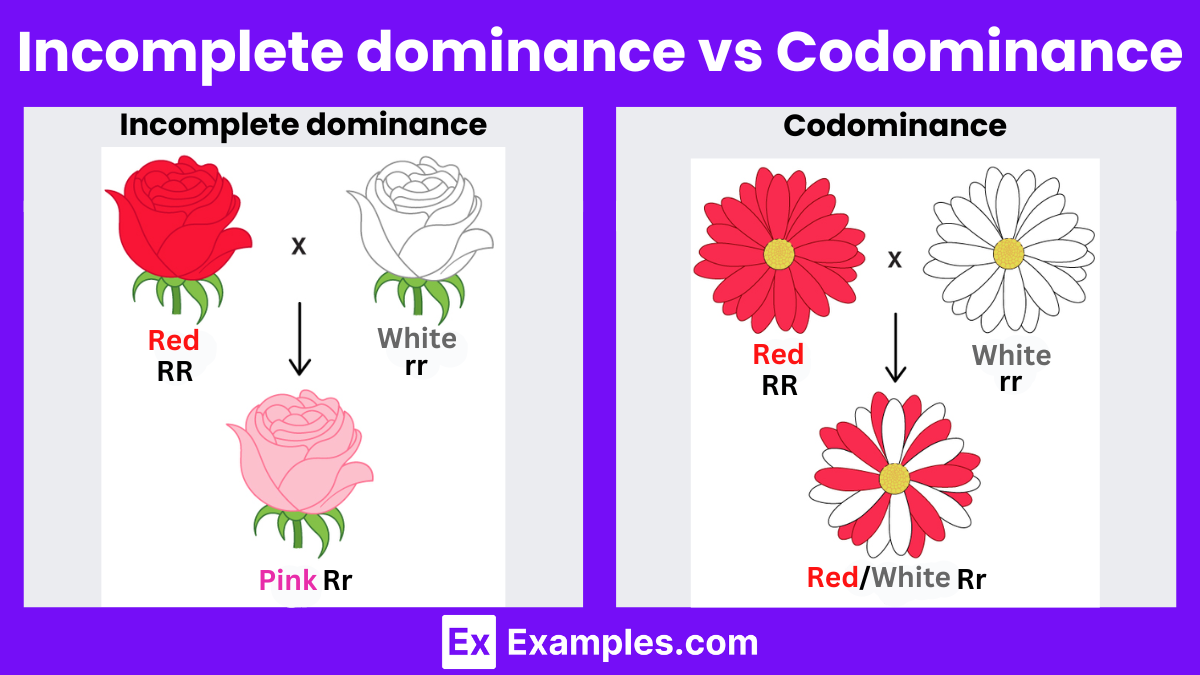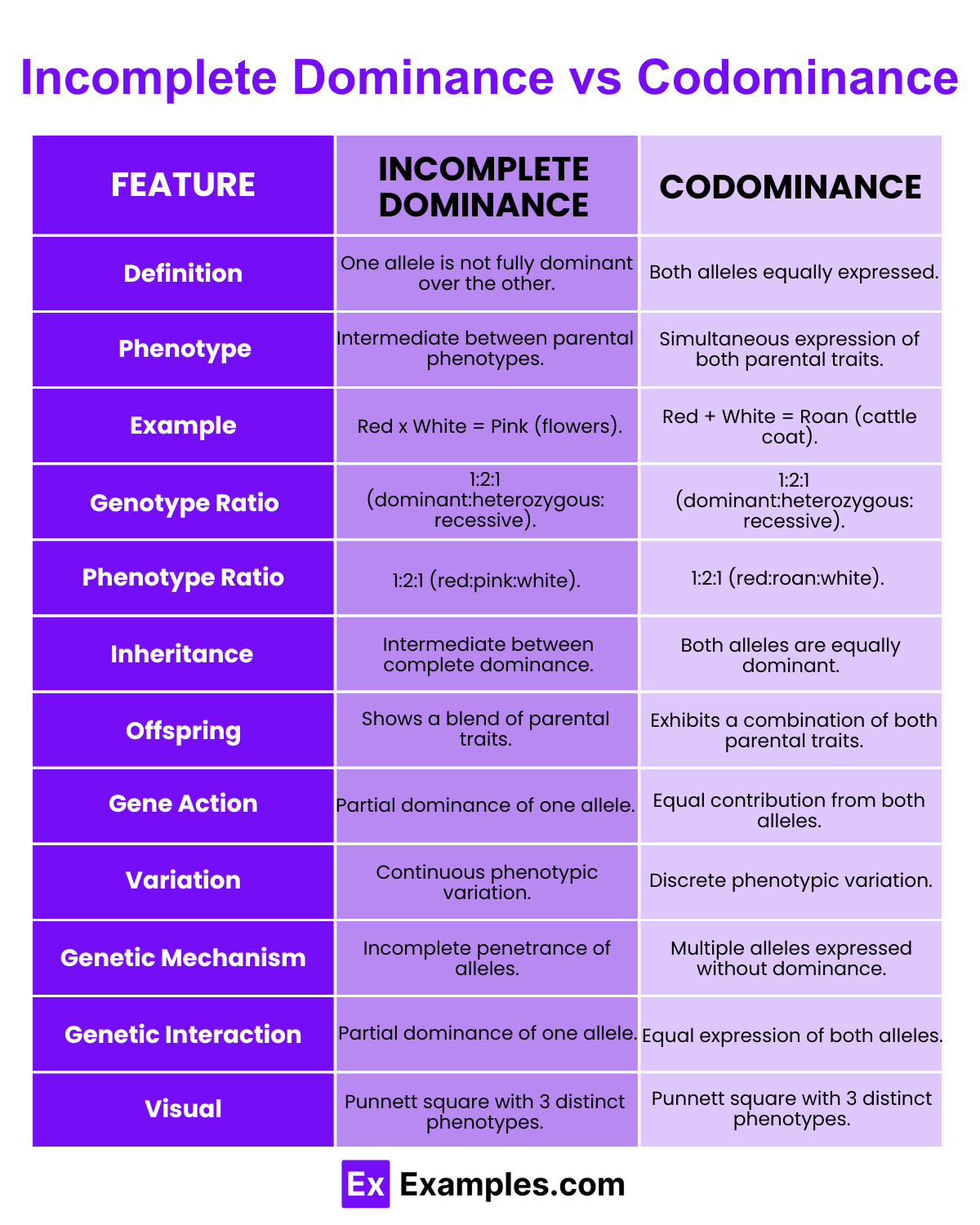In incomplete dominance, the phenotype of the heterozygote is:
The same as one of the homozygotes.
A blend of both homozygotes.
The same as the dominant homozygote.
The same as the recessive homozygote.

Genetics often reveals complex patterns of inheritance that challenge the classic Mendelian dichotomies of dominant and recessive traits. Two such intriguing patterns are incomplete dominance and codominance, each illustrating unique interactions between alleles. In incomplete dominance, the offspring exhibit a blend of parental traits, neither allele fully asserting dominance over the other. Conversely, codominance allows both alleles to manifest simultaneously without blending, leading to offspring that express both parental traits distinctly. This article clears differences between these genetic phenomena, highlighting how they contribute to the diversity of biological traits observed in nature.
Incomplete codominance is a genetic phenomenon where two different alleles for a specific trait are both expressed, resulting in offspring with a phenotype that is a blend of both parental traits. Unlike complete dominance where one allele completely masks another, incomplete codominance allows each allele’s effects to be partially visible in the phenotype.
A classic example of incomplete codominance is the flower color in certain species of snapdragons, where crossing a red-flowered plant with a white-flowered plant results in offspring with pink flowers. Here, neither the red nor the white allele is dominant, so the resulting pink coloration is a mix of both, demonstrating that neither allele can completely mask the effect of the other. This blending of traits showcases the nuanced interactions of alleles that do not follow the classic Mendelian dominant-recessive inheritance pattern.
Codominance is a genetic phenomenon where two different alleles of a gene are both fully expressed in an organism’s phenotype, neither being dominant or recessive. This results in offspring exhibiting characteristics of both alleles equally. A classic example of codominance is seen in the AB blood type in humans, where alleles for both A and B blood types are expressed, leading to a blood type that has both A and B antigens on the surface of red blood cells. Unlike incomplete dominance where the phenotype is a blend or intermediate, codominance shows both traits distinctly and simultaneously.

Understanding the nuances of genetic inheritance is key to comprehending how traits are passed from parents to offspring. Two important patterns that deviate from Mendel’s principles of dominance are incomplete dominance and codominance. These mechanisms play crucial roles in determining the phenotypes (observable characteristics) of organisms. Below is a detailed comparison of these two genetic phenomena in a table format:
| Characteristic | Incomplete Dominance | Codominance |
|---|---|---|
| Definition | A genetic situation in which one allele does not completely dominate another allele, resulting in a new phenotype. | A scenario where both alleles in a gene pair are fully expressed, leading to a phenotype that shows both traits simultaneously. |
| Phenotype of Offspring | The phenotype is a blend or mixture of the parent traits. | Both parental traits appear together without blending. |
| Example | Snapdragon Flowers: Red flowered plant crossed with a white flowered plant produces offspring with pink flowers. | Blood Type in Humans: A person with one allele for A blood type and one for B blood type will have type AB blood, expressing both phenotypes. |
| Allelic Interaction | The alleles mix to produce an intermediate phenotype. | The alleles maintain separate identities and are expressed equally. |
| Genotypic Ratio | Typically 1:2:1 (one homozygous dominant, two heterozygous, one homozygous recessive). | Typically 1:2:1 (one homozygous for the first allele, two heterozygous, one homozygous for the second allele). |
| Phenotypic Expression | Intermediate between the parents. | Both traits expressed fully and separately visible in the phenotype. |
| Inheritance Pattern | Neither allele is dominant over the other; both have a partial effect. | Both alleles in the heterozygote are fully expressed. |
| Visual Representation | Often results in a dilution of dominant phenotypes. | Results in a mosaic or speckled pattern of both phenotypes. |
Incomplete dominance blends traits, while codominance displays both traits distinctly without blending.
A classic example of codominance is the ABO blood group system, where types A and B are both expressed.
An example of incomplete dominance is the flower color in snapdragons, where red crossed with white produces pink flowers.
Codominance shows both alleles equally without mixing, unlike incomplete dominance which produces a blended phenotype.
The major difference is that codominance exhibits both alleles distinctly, whereas dominance shows only one dominant allele’s trait.
Text prompt
Add Tone
10 Examples of Public speaking
20 Examples of Gas lighting
In incomplete dominance, the phenotype of the heterozygote is:
The same as one of the homozygotes.
A blend of both homozygotes.
The same as the dominant homozygote.
The same as the recessive homozygote.
Which of the following is an example of codominance?
A pink flower resulting from red and white parents.
A red and white flower where both colors are visible.
A red flower resulting from red and white parents.
A white flower resulting from red and white parents.
In snapdragons, red (R) and white (W) flowers exhibit incomplete dominance. What is the phenotype of an RW plant?
Red
White
Pink
Red and white striped
Which blood type is an example of codominance?
Type A
Type B
Type AB
Type O
What is the result of a cross between two pink snapdragons (RW x RW) where red (R) and white (W) show incomplete dominance?
100% pink
50% red, 50% white
25% red, 50% pink, 25% white
75% pink, 25% white
Which scenario best illustrates incomplete dominance?
A white cow and a red cow produce a calf that is roan (red and white patches).
A white flower and a red flower produce all red offspring.
A black dog and a white dog produce gray puppies.
A brown horse and a white horse produce a horse with brown and white spots.
Codominance can be observed in the coat color of certain cattle breeds. If a homozygous red (RR) cow is crossed with a homozygous white (WW) cow, what will the heterozygous (RW) offspring look like?
Red
White
Pink
Roan (red and white patches)
Which statement about incomplete dominance and codominance is true?
Both incomplete dominance and codominance show a blend of parental traits.
Incomplete dominance results in a completely dominant phenotype.
Both incomplete dominance and codominance hide the recessive allele.
Codominance shows both parental traits distinctly without blending.
In human blood types, what genotype represents codominance?
IAIA
IBi
IAIB
ii
Which of the following crosses illustrates incomplete dominance?
A black and a white rabbit producing a spotted black and white rabbit.
A red and a white snapdragon producing pink snapdragons.
A tall and a short pea plant producing all tall plants.
A brown and a white mouse producing a brown and white mouse.
Before you leave, take our quick quiz to enhance your learning!

